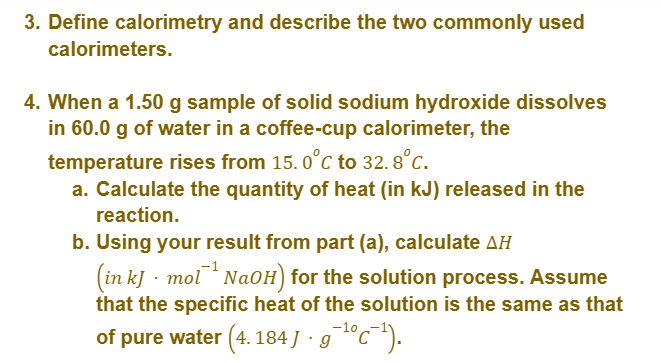3. Define calorimetry and describe the two commonly used calorimeters. 4. When a 1.50 g sample of solid sodium hydroxide dissolves in 60.0 g of water in a coffee-cup calorimeter, the temperature rises from 15.0°C to 32.8°C. a. Calculate the quantity of heat (in kJ) released in the reaction. b. Using your result from part (a), calculate AH (in kJ mol NaOH) for the solution process. Assume that the specific heat of the solution is the same as that of pure water (4. 184 J · g¯¹°c¯¹).
3. Define calorimetry and describe the two commonly used calorimeters. 4. When a 1.50 g sample of solid sodium hydroxide dissolves in 60.0 g of water in a coffee-cup calorimeter, the temperature rises from 15.0°C to 32.8°C. a. Calculate the quantity of heat (in kJ) released in the reaction. b. Using your result from part (a), calculate AH (in kJ mol NaOH) for the solution process. Assume that the specific heat of the solution is the same as that of pure water (4. 184 J · g¯¹°c¯¹).
Chemistry for Engineering Students
4th Edition
ISBN:9781337398909
Author:Lawrence S. Brown, Tom Holme
Publisher:Lawrence S. Brown, Tom Holme
Chapter9: Energy And Chemistry
Section: Chapter Questions
Problem 9.50PAE: 9.50 When a 13.0-g sample of NaOH(s) dissolves in 400.0 mL of water in a coffee cup calorimeter, the...
Related questions
Question
100%
[C&D-question] PLEASE PROVIDE THE CORRECT AND SOLUTION. MUST ANSWER TWO QUESTIONS (kindly provide complete and full solution. i won't like your solution if it is incomplete or not clear enough to read.)

Transcribed Image Text:3. Define calorimetry and describe the two commonly used
calorimeters.
4. When a 1.50 g sample of solid sodium hydroxide dissolves
in 60.0 g of water in a coffee-cup calorimeter, the
temperature rises from 15.0°C to 32.8°C.
a. Calculate the quantity of heat (in kJ) released in the
reaction.
b. Using your result from part (a), calculate AH
(in kJ mol NaOH) for the solution process. Assume
that the specific heat of the solution is the same as that
of pure water (4. 184 J · g¯¹°c¯¹).
Expert Solution
This question has been solved!
Explore an expertly crafted, step-by-step solution for a thorough understanding of key concepts.
Step by step
Solved in 2 steps with 2 images

Knowledge Booster
Learn more about
Need a deep-dive on the concept behind this application? Look no further. Learn more about this topic, chemistry and related others by exploring similar questions and additional content below.Recommended textbooks for you

Chemistry for Engineering Students
Chemistry
ISBN:
9781337398909
Author:
Lawrence S. Brown, Tom Holme
Publisher:
Cengage Learning

Chemistry: An Atoms First Approach
Chemistry
ISBN:
9781305079243
Author:
Steven S. Zumdahl, Susan A. Zumdahl
Publisher:
Cengage Learning

Chemistry & Chemical Reactivity
Chemistry
ISBN:
9781337399074
Author:
John C. Kotz, Paul M. Treichel, John Townsend, David Treichel
Publisher:
Cengage Learning

Chemistry for Engineering Students
Chemistry
ISBN:
9781337398909
Author:
Lawrence S. Brown, Tom Holme
Publisher:
Cengage Learning

Chemistry: An Atoms First Approach
Chemistry
ISBN:
9781305079243
Author:
Steven S. Zumdahl, Susan A. Zumdahl
Publisher:
Cengage Learning

Chemistry & Chemical Reactivity
Chemistry
ISBN:
9781337399074
Author:
John C. Kotz, Paul M. Treichel, John Townsend, David Treichel
Publisher:
Cengage Learning

Chemistry & Chemical Reactivity
Chemistry
ISBN:
9781133949640
Author:
John C. Kotz, Paul M. Treichel, John Townsend, David Treichel
Publisher:
Cengage Learning

Chemistry by OpenStax (2015-05-04)
Chemistry
ISBN:
9781938168390
Author:
Klaus Theopold, Richard H Langley, Paul Flowers, William R. Robinson, Mark Blaser
Publisher:
OpenStax

Chemistry
Chemistry
ISBN:
9781305957404
Author:
Steven S. Zumdahl, Susan A. Zumdahl, Donald J. DeCoste
Publisher:
Cengage Learning